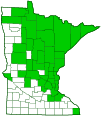pearly everlasting
(Anaphalis margaritacea)
Conservation • Wetland • Description • Habitat • Ecology • Use • Distribution • Taxonomy
Description |
||
Pearly everlasting is a 8″ to 32″ tall, erect, perennial forb that rises usually on a single stem from a slender, horizontal, underground stem (rhizome) and fibrous roots. The stems are very leafy, usually erect, and often branched. They are densely and closely covered with white, woolly hairs. As the stem ages the hairs become tan to rust colored and less dense. There are no glands on the stem. The sap is not milky. The plant is not aromatic. Stem leaves are alternate, numerous, stalkless, and linear to lance-shaped. Lower stem leaves are up to 4¾″ long and up to about ⅝″ wide. The leaf blade is bluntly to sharply pointed at the tip. It is wedge-shaped and sometimes slightly expanded and clasping at the base. The base of the blade extends down the stem. There is a prominent central vein and two faint lateral veins that arch toward the tip. The lower surface is densely covered with white woolly hairs, becoming less hairy with age. The upper surface is dark green and usually less hairy, becoming almost hairless with age. There are no glands on the leaf surfaces, or, if present, the glands are very sparse and inconspicuous. The margins are untoothed and are sometimes curled under. Basal leaves are similar in size and shape to lower stem leaves. They are usually absent by flowering time. The inflorescence is a short, broad, rounded to almost flat-topped, branched cluster (panicle) of numerous crowded flower heads at the end of the stem and branches. The individual flower heads are no more than ⅜″ wide. They are globe-shaped and are on ⅛″ to 5 ⁄16″ long, densely hairy stalks. Male (staminate) and female (pistillate) flowers are borne on separate plants. Female flower heads usually have a few staminate flowers, however the plants are not self-fertile. Separate male and female plants must be present to produce seed. The base of the flower head (involucre) is broadly egg-shaped to cup shaped and 3 ⁄16″ to ¼″ high. It is composed of 8 to 12 overlapping series of modified leaves (bracts). The involucral bracts (phyllaries) are egg-shaped to nearly linear, mostly bluntly pointed at the tip, and mostly loosely appressed. They are bright white, opaque, and usually slightly shiny, at least above the middle, and brownish at the base. When the pistillate flower is in fruit the bracts dry and spread widely. Female flower heads have a compact disk-like arrangement of 50 to 150 or more pistillate flowers and usually 2 to 4 staminate flowers at the center. The flowers are yellow to greenish-yellow. Male flower heads have 30 to 55 all staminate flowers. The fruit is a dry, brown, one-seeded, 1 ⁄64″ to 1 ⁄32″ long seed capsule (cypsela) with a tuft of 10 to 20 short bristles (pappus) attached to the end. The pappi fall off readily. |
||
Height |
||
8″ to 32″ |
||
Flower Color |
||
White bracts, yellowish disk |
||
Similar Species |
||
Rabbit-tobacco (Pseudognaphalium obtusifolium) flower heads are narrow, twice as long as wide. All flower heads have marginal pistillate flowers and central perfect (with both staminate and pistillate parts) flowers. |
||
Habitat |
||
Dry. Woodland and forest edges and openings, fields, roadsides, and other disturbed sites. Full sun to partial shade. |
||
Ecology |
||
Flowering |
||
July to September |
||
Pests and Diseases |
||
|
||
Use |
||
|
||
Distribution |
||||
|
Sources |
|||
| 5/24/2023 | ||||
Nativity |
||||
Native |
||||
Occurrence |
||||
Common |
||||
Taxonomy |
|||
| Kingdom | Plantae (Plants) | ||
| Division | Tracheophyta (Vascular Plants) | ||
| Subdivision | Spermatophytina (Seed Plants) | ||
| Class | Magnoliopsida (Dicots) | ||
Order |
Asterales (Sunflowers, Bellflowers, Fanflowers, and Allies) | ||
Family |
Asteraceae (Sunflowers, Daisies, Asters, and Allies) | ||
| Subfamily | Asteroideae | ||
| Supertribe | Asterodae | ||
| Tribe | Gnaphalieae (paper daisies) | ||
| Subtribe | Gnaphaliinae (cudweeds, everlastings, and pussytoes) | ||
| Genus | Anaphalis (everlastings) | ||
Subordinate Taxa |
|||
|
|||
Synonyms |
|||
Anaphalis margaritacea var. angustior Anaphalis margaritacea var. intercedens Anaphalis margaritacea var. occidentalis Anaphalis margaritacea var. revoluta Anaphalis margaritacea var. subalpina Anaphalis occidentalis Gnaphalium margaritaceum |
|||
Common Names |
|||
common pearleverlasting pearly everlasting pearly-everlasting western pearly everlasting western pearlyeverlasting |
|||
Glossary
Bract
Modified leaf at the base of a flower stalk, flower cluster, or inflorescence.
Cypsela
A dry, one-chambered, single-seeded seed capsule, formed from a single carpel, with the seed attached to the membranous outer layer (wall) only by the seed stalk; the wall, formed from the wall of the inferior ovary and also from other tissues derived from the receptacle or hypanthium, does not split open at maturity, but relies on decay or predation to release the contents.
Involucre
A whorl of bracts beneath or surrounding a flower, flower head, or flower cluster.
Linear
Long, straight, and narrow, with more or less parallel sides, like a blade of grass.
Panicle
A pyramidal inflorescence with a main stem and branches. Flowers on the lower, longer branches mature earlier than those on the shorter, upper ones.
Pappus
The modified calyx composed of awns, scales, bristles, or feather-like hairs in plants of the Asteraceae family.
Perfect
Referring to a flower that has both male and female reproductive organs.
Phyllary
An individual bract within the involucre of a plant in the Asteraceae family.
Pistillate
Referring to a flower that has a female reproductive organ (pistil) but does not have male reproductive organs (stamens).
Rhizome
A horizontal, usually underground stem. It serves as a reproductive structure, producing roots below and shoots above at the nodes.
Staminate
Referring to a flower that has a male reproductive organs (stamens) but does not have a female reproductive organ (pistil
Visitor Photos |
|||||
Share your photo of this plant. |
|||||
| This button not working for you? Simply email us at info@MinnesotaSeasons.com. Attach one or more photos and, if you like, a caption. |
|||||
Luciearl |
|||||
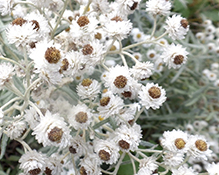 |
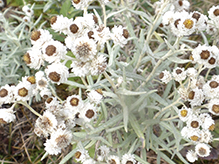 |
||||
MinnesotaSeasons.com Photos |
|||||
Plant |
|||||
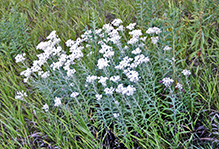 |
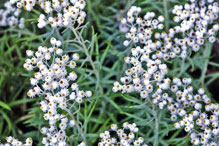 |
||||
Inflorescence |
|||||
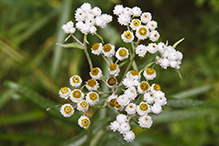 |
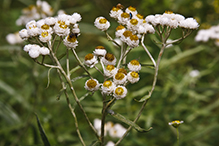 |
||||
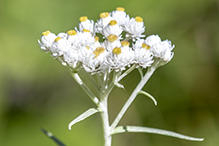 |
|||||
Flower Heads |
|||||
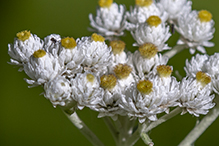 |
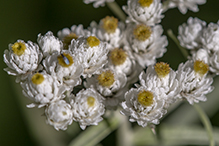 |
||||
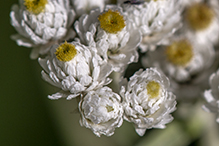 |
|||||
Leaves |
|||||
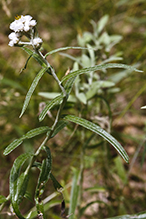 |
|||||

Slideshows |
||

Visitor Videos |
|||
Share your video of this plant. |
|||
| This button not working for you? Simply email us at info@MinnesotaSeasons.com. Attach a video, a YouTube link, or a cloud storage link. |
|||
Other Videos |
|||
| Western Pearly Everlasting (Anaphalis margaritacea) Wandering Sole TV |
|||
About
Published on Jul 26, 2013 Pearly Everlasting (Anaphalis margaritacea), a member of the Asteraceae (sunflower) family, growing in the East Kootenays of British Columbia. The flowers maintain their colour and shape until the first snows of winter, or when dried - giving the plant its "everlasting" name. They usually do not bloom until mid to late summer, but they really arrived early this year. I've been seeing them since early July. The Nlaka'pmx peoples used the plant to treat rheumatic fever and coughs, while the Okanagan peoples made a tea from the roots in order to treat upset stomachs. |
|||
| Anaphalis margaritacea wetvideocamera |
|||
About
Published on Oct 12, 2013 Pearly Everlasting is a member of the Aster or Asteraceae family. Its showy white blooms can last into the winter. |
|||
| yellow jacket on pearly everlasting Crystal Colby Mulry |
|||
About
Published on Sep 29, 2013 No description available. |
|||
| Mountain Moment: Hover Fly Paradise Mount Rainier National Park |
|||
About
Published on Sep 13, 2013 Pearly everlasting is in peak bloom in the Paradise area of the park. Hover flies, which feed on wildflower pollen, also seem to be at their peak as is evident in this Mountain Moment. Hover flies mimic the bold yellow and black stripes of bees to avoid predators, but unlike bees have no stingers. In subalpine meadows, hover flies pollinate more flowers than bees. This footage was filmed alongside the Paradise Valley Road on September 3, 2013. |
|||

|
Created: Last Updated: © MinnesotaSeasons.com. All rights reserved. |
